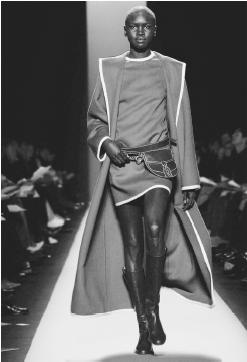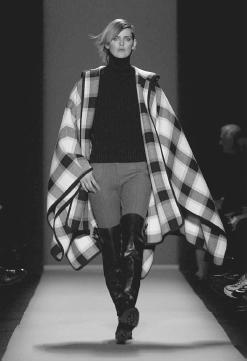Michael Kors - Fashion Designer Encyclopedia
American designer
Born: Long Island, New York, 9 August 1959. Education: Studied fashion design at Fashion Institute of Technology, New York, 1977. Career: Sales assistant at Lothar's boutique, New York, 1977-78 (while studying at FIT), then designer and display director, 1978-80; established own label for women's sportswear, 1981; designer, Lyle & Scott, 1989; introduced lower-priced Kors line and menswear collection, 1990; designer, womenswear collection, for Erreuno J, from 1990; bridge line discontinued, company reorganized, 1993; hired as creative director for Celine, 1997; reintroduced own mens-wear collection label, 1998; took over all design responsibilities at Celine, 1998; created costumes for film The Thomas Crown Affair, 1999; one-third of business purchased by LMVH (Moët Hennessy Louis Vuitton), 1999; opened Manhattan store for own labels, 2000; stake in business acquired by Onward Kashiyama USA, 2000; introduced first fragrance, 2000; debuted licensed handbags, footwear, and eyewear, 2001. Awards: Dupont American Original award, 1983; Council of Fashion Designers Womenswear Designer of the Year, 1999; Featured Designer at Neiman Marcus Crystal Charity Ball luncheon, 2000. Address: 550 Seventh Avenue, New York, NY 10018, USA.
Publications
On KORS:
Books
Stegemeyer, Anne, Who's Who in Fashion, Third Edition, New York, 1996.

Articles
Sinclaire, Paul, and Lesley Jane Nonkin, "Designer, Client: The Modern Equation," in Vogue (New York), November 1987.
Boehlert, Bart, "On Kors," in Connoisseur (New York), August 1988.
Hochswender, Woody, "Designers on a Quiet Road to Success," in the New York Times, 1 November 1988.
Reiger, Nancy, "Michael Kors Keeps It Cool," in Footwear News (New York), 30 July 1990.
Worthington, Christa, "The Three Choicest Dudes in the USA," in the Sunday Times Magazine (London), 26 August 1990.
Hochswender, Woody, "Casual, for the Car Pool (or Whatever)," in the New York Times, 9 September 1990.
——, "Amid the Scramble of the Style Race, Individuality Lives," in the New York Times, 1 November 1990.
Darnton, Nina, "Acclaim for a New Mister Clean: Move Over, Calvin, and Make Room for Kors," in Newsweek, 3 December 1990.
Baker, Martha, "Of Kors," in New York, 17 December 1990.
Goodman, Wendy, "Upper-Deck Accommodations," in HG (New York), October 1991.
Rudolph, Barbara, "Why Chic Is Now Cheaper," in Time, 11 November 1991.
Smith, Liz, "Just the Way Mother Likes It," in the Times (London), 13 April 1992.
Morris, Bernadine, "The Evolution of Leather's Gentler Image," in the New York Times, 28 April 1992.
"New York: Michael Kors," in WWD, 7 November 1994.
Lockwood, Lisa, "Kors Designing Bridge Line for Onward Kashiyama," in WWD, 7 February 1995.
DeCaro, Frank, "Why Isn't He Calvin Klein? Michael Kors has Everything but Megastardom—So Far," in Newsweek, 29 July 1996.
Hanson, Holly, "Life and Business is Looking Up for Designer Michael Kors," from Knight-Ridder/Tribune News Service, 12 September 1996.
Weisman, Katherine, "Kors, Celine Confirm Post as Designer," in WWD, 24 November 1997.
White, Constance C.R., "Another Design Talent is Lured Away to France," in the New York Times, 25 November 1997.
"LMVH Buys 33-Percent Share in the Michael Kors Fashion House," in the New York Times, 17 February 1999.
Givhan, Robin, "Best Western: Michael Kors Breathes New Life Into a Dusty Genre," in the Washington Post, 18 February 1999.
Schiro, Anne-Marie, "An Ear for What Women Want," in the New York Times, 6 April 1999.
Meers, Erik, and Nancy Matsumoto, "Of Kors: After 18 Years, Designer Michael Kors Becomes Fashion's Man of the Moment," in People, 9 August 1999.
Edelson, Sharon, "Celine Plans Flagship for Madison Avenue," in WWD, 10 August 1999.
Boyes, Kathleen, "Michael Kors: A Young Designer Stays on the Sane Side of Fashion," in WWD, 13 September 1999.
"Michael Kors," in Current Biography, January 2000.
Horyn, Cathy, "For Kors and Lauren, a Fondness for the Paddock," in the New York Times, 15 February 2000.
Quintanilla, Michael, "Look, Ma! It's About More than Mutual Affection and Respect," in the Los Angeles Times, 12 May 2000.
Comita, Jenny, "Kors Scores," in US Weekly, 18 September 2000.
Haber, Holly, "Kors, Of Course," in WWD, 5 October 2000.
Givhan, Robin, "Flirting With the Feminine: Paris Spring Collections Follow the Curves," in the Washington Post, 12 October 2000.
Ozzard, Janet, "Kors Inks Deal with Kashiyama," in WWD, 13November 2000.
Hessen, Wendy, "Michael Kors Cadre Grows, with Eyewear for Spring," in WWD, 5 March 2001.
Diamond, Kerry, "Michael Kors to Launch Men's Fragrance," in WWD, April 2001.
***
Perhaps the best summary of Michael Kors was offered by Woody Hochswender of the New York Times in November 1988 when he said, "Mr. Kors showed that simple doesn't have to be zero." Kors has been a minimalist working within a sportswear tradition. In this, he has perpetuated and advanced ideas of Halston, including strong sexuality. He particularly flattered the gym-toned body of the late 1980s and early 1990s in stretchy, simple dresses calling attention to the body within. Minimalists in art and architecture might seem to remove themselves from the figure and human proportion; the irony is that a fashion minimalist like Kors has drawn attention to the figure within.

Although he has shown patterns, Kors prefers neutral color fields and emphasizes the apparel of the fabric with luxurious wools and cashmere for fall-winter and stretch and cotton for spring-summer. Leather in shirts, skirts, and jackets is essential for any Kors fall-winter collection; trousers are critical in all collections; and layering is important, even light layers in spring-summer collections. Kors spoke the language of separates in arguing with Bernadine Morris of the New York Times in April 1992 stating, "Store buyers are zeroing in on the idea that women will probably not be shopping for entire new wardrobes. A single piece or two that will enliven everything else is what they will be searching for. Leather fills the bill—suede for times they are in a softer mood, smooth leather when they feel more aggressive." Kors' distinctive position as a leading minimalist in late 20th-century sportswear was achieved by the precise harmony of color and fabric in separates.
There has been some affinity between Kors and Donna Karan, both creating innovative bodysuits, sensual stretch skirts and tops, and other sportswear elements, as well as borrowings from menswear. In fact, Karan and Kors are somewhat similar in their menswear collections as well. They shared the dubious distinction of both offering bodyshirts (underwear attached to shirts) in menswear collections for fall 1992. If anything, Kors' minimalism was a little more referential than Karan's—he deliberately evoked the glamor and sportiness of the 1930s, the "Belafonte" shirt of the 1950s, or vinyl clothing of the late 1960s. Despite his proclivity to the most simple in shapes, he has produced clothes that are undeniably romantic and Kors admits to loving the movies, telling HG 's Wendy Goodman in October 1991 that he believed he had only two choices in life: movie star or fashion designer.
Of Claire McCardell, Kors acknowledges his admiration of her clothes, seen in old magazines, "They were timeless. She was the first designer to look not to Paris for inspiration but to the needs of the American woman." A spring-summer silk shantung scarf blazer by Kors reminds one of the McCardell twists and ties but with all the sleek romance of a Noel Coward drawing room. Like the other sportswear designers, he learns from and responds to his clients and potential customers. He told Bart Boehlert of Connoisseur in August 1988 that he likes to talk with a variety of women from his office, customers, or his mother to ask what they most want in clothing.
His sportswear-based pragmatism has been particularly effective as a monitor to the sexuality of his clothing. A bare Kors dress or jumpsuit may be audaciously sexy, but tone it down with a neutral jacket or other cover-up and it can become suitable for the office. Conversely, Kors can take a simple skirt and blouse from the office setting into hot evening life with the addition of a leather jacket or a satin swing jacket. Only partly facetiously, he told Hochswender of the New York Times (September 1990) of his comfortable and chic Kors line, "In Texas they call it carpool couture. They all want to wear something pretty for the carpool." Kors creates the pretty, the sexy, and the highly practical, pure mastery in American sportswear.
Throughout Kors' decades as a designer, he has maintained the same casual-yet-luxurious sensibility he has been known for since launching his business in 1981. In the late 1990s and early 2000s, fashion trends caught up with his longtime focus on feminine, elegant simplicity, and he finally moved to the industry forefront. Whether taking inspiration from the equestrian world or from Native American culture, he has remained constant in his use of luxurious, often unique fabrics to create upscale yet wearable pieces.
Kors designs two lines simultaneously, his own labels and those of the French house Celine, for which he added design responsibilities in 1997. Both feature his identifiable signature look, yet each is distinct. As Kors told Jenny Comita in the US Weekly Style section (September 2000), Celine is slightly more indulgent, whereas Kors and the lower-priced Kors by Michael Kors are sharper and more efficient. The designer is credited with reviving the more than 50-year-old Celine brand. Additionally, his work for the French house has been cited as a key factor in a new freshness in his signature lines.
In 1999 LVMH (Moët Hennessy Louis Vuitton), owner of the Celine label, purchased a third of Kors' D5 signature business. Kors hoped the acquisition would boost his presence internationally as well as allow him to expand his licensing and advertising activity, neither of which he had pursued aggressively in the past. Wholesale sales for the Kors D5 signature labels in 1999 were $30 million, according to the New York Times , with sales growing 60 to 70 percent annually for two years.
Kors sold an additional tenth of his business in 2000 to Onward Kashiyama USA, a licensee for the Kors by Michael Kors bridge line (which was reintroduced in 1996 after having been discontinued several years earlier). The designer hoped the new relationship would support plans to expand further into Asia. Next came a Kors first—the introduction of a women's fragrance—launched in fall 2000 through licensee Parfums Givenchy. The debut was successful enough for Kors to expand into men's scents the following year. He had also begun showing men's clothing again, after a hiatus, as part of his women's runway show in spring 1998.
In 2001, Kors—who considers fragrances one of his most personal creations—and Parfums Givenchy developed three new scents called Notes from Michael which could be worn in any combination or alone. In addition to fragrance, Kors has focused on expanding the rest of his licensed products since the turn of the century, including handbags, footwear, and eyewear, which all debuted in spring 2001.
Some observers have criticized Kors for being bland and predictable and for never departing from his focus on casual luxury, either in his work for Celine or for his own labels. Yet many praise his confidence in sticking with what he believes his customers want and remaining unaffected by short-lived trends. He always creates pieces that can be mixed and matched in unexpected ways—day with night, summer with winter, big and bulky with silky and slim. Kors is proud his clothes are bought by a customer base that ranges from 20-somethings to much more mature women.
—Richard Martin;
updated by Karen Raugust
Comment about this article, ask questions, or add new information about this topic: